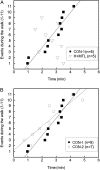Learning and remembering real-world events after medial temporal lobe damage
- PMID: 27821761
- PMCID: PMC5127365
- DOI: 10.1073/pnas.1617025113
Learning and remembering real-world events after medial temporal lobe damage
Abstract
The hippocampus is important for autobiographical memory, but its role is unclear. In the study, patients with hippocampal damage and controls were taken on a 25-min walk on the University of California, San Diego, campus during which 11 planned events occurred. Memory was tested directly after the walk. In addition, a second group of controls took the same walk and were tested after 1 mo. Patients with hippocampal damage remembered fewer details than controls tested directly after the walk but remembered a similar number of details as controls tested after 1 mo. Notably, the details that were reported by patients had the characteristics of episodic recollection and included references to particular places and events. Patients exhibited no special difficulty remembering spatial details in comparison with nonspatial details. Last, whereas both control groups tended to recall the events of the walk in chronological order, the order in which patients recalled the events was unrelated to the order in which they occurred. The findings illuminate the role of the hippocampus in autobiographical memory and in the spatial and nonspatial aspects of episodic recollection.
Keywords: autobiographical memory; hippocampus; prospective memory.
Conflict of interest statement
The authors declare no conflict of interest.
Figures






Similar articles
-
Autobiographical memory after temporal lobe resection: neuropsychological and MRI volumetric findings.Brain. 2007 Dec;130(Pt 12):3184-99. doi: 10.1093/brain/awm258. Epub 2007 Nov 6. Brain. 2007. PMID: 17986479
-
The nature of recollection across months and years and after medial temporal lobe damage.Proc Natl Acad Sci U S A. 2019 Mar 5;116(10):4619-4624. doi: 10.1073/pnas.1820765116. Epub 2019 Feb 21. Proc Natl Acad Sci U S A. 2019. PMID: 30792351 Free PMC article.
-
The temporal unraveling of autobiographical memory narratives in patients with temporal lobe epilepsy or excisions.Hippocampus. 2011 Apr;21(4):409-21. doi: 10.1002/hipo.20757. Hippocampus. 2011. PMID: 20082294
-
Recollection of episodic memory within the medial temporal lobe: behavioural dissociations from other types of memory.Behav Brain Res. 2010 Dec 31;215(2):310-7. doi: 10.1016/j.bbr.2009.10.019. Epub 2009 Oct 20. Behav Brain Res. 2010. PMID: 19850082 Review.
-
On remembering and forgetting our autobiographical pasts: retrograde amnesia and Andrew Mayes's contribution to neuropsychological method.Neuropsychologia. 2012 Nov;50(13):2961-72. doi: 10.1016/j.neuropsychologia.2012.07.028. Epub 2012 Aug 2. Neuropsychologia. 2012. PMID: 22884958 Review.
Cited by 18 articles
-
Multivariate FMRI Signatures of Learning in a Hebb Repetition Paradigm With Tone Sequences.Front Neurol. 2021 Nov 29;12:674275. doi: 10.3389/fneur.2021.674275. eCollection 2021. Front Neurol. 2021. PMID: 34912281 Free PMC article.
-
Neural responses to shot changes by cut in cinematographic editing: An EEG (ERD/ERS) study.PLoS One. 2021 Oct 14;16(10):e0258485. doi: 10.1371/journal.pone.0258485. eCollection 2021. PLoS One. 2021. PMID: 34648560 Free PMC article.
-
Watching Movies Unfold, a Frame-by-Frame Analysis of the Associated Neural Dynamics.eNeuro. 2021 Jul 9;8(4):ENEURO.0099-21.2021. doi: 10.1523/ENEURO.0099-21.2021. Print 2021 Jul-Aug. eNeuro. 2021. PMID: 34193513 Free PMC article.
-
Virtual reality video game improves high-fidelity memory in older adults.Sci Rep. 2021 Jan 28;11(1):2552. doi: 10.1038/s41598-021-82109-3. Sci Rep. 2021. PMID: 33510315 Free PMC article. Clinical Trial.
-
A temporal record of the past with a spectrum of time constants in the monkey entorhinal cortex.Proc Natl Acad Sci U S A. 2020 Aug 18;117(33):20274-20283. doi: 10.1073/pnas.1917197117. Epub 2020 Aug 3. Proc Natl Acad Sci U S A. 2020. PMID: 32747574 Free PMC article.
Publication types
MeSH terms
LinkOut - more resources
Full Text Sources
Other Literature Sources

